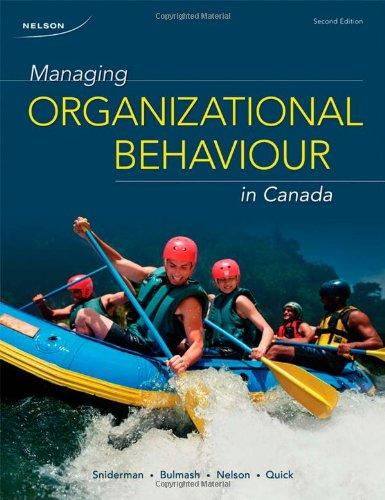The Ontario plant of Columbia paper is responsible for producing specialty coated papers. This plant has undergone
Question:
The Ontario plant of Columbia paper is responsible for producing specialty coated papers. This plant has undergone some modernization but not as much as the Quebec plant. The company is hierarchical in structure with four departments. Decisions flow from the top. The finishing department supervisor, Mike Tran, is very autocratic, closely supervising the day shift, using fear and aggression to get the work done. New employees receive very little formal introduction to the job and must “pass” barriers to be accepted by the team. Employees like the plant manager, Susan Burns, and her open door policy. The supervisors don’t, considering him to be too soft. Monthly meetings are held with supervisors and staff on that shift. The informal team leader used intimidation with other team members and is continually filing grievances with the union. Major concerns at this point are poor work quality, high turnover, number of grievances, absenteeism and low morale. Slowdowns and equipment sabotage are common.
1. Use expectancy theory to (a) explore the motivational problems in Columbia Paper’s finishing department and (b) make recommendations for improvement.
2. (a) Using the model of team effectiveness in the text, identify the various conditions, internal process and blocking behaviours that are reducing team effectiveness in the finishing department. (b) What do you recommend that the plant manager and/or supervisor do to improve team effectiveness?
3. (a) Use the Vroom Decision-Making Tree to compare and contrast Mike Tran and Susan Burns’s forms of decision-making. (b) Recommend which forms are most appropriate, given the facts of the case.
4. Using organizational behaviour theory and facts given in the case to support your points of view, identify (a) all the individual sources of power and (b) all the influence tactics used by Susan Burns, Mike Tran, Rashid Khan, and Gerry Sharpe.
5. (a) Using one of the leadership theories discussed in our text, classify the leadership styles of both, the plant manager, Susan Burns and the finishing supervisor, Mike Tran citing facts from the case to support your classification. (b) Use the same leadership theory to assess the impact of their leadership styles.
6. (a) What are all the personal and structural sources of conflict currently evident between the plant manager Susan Burns and the finishing supervisor Mike Tran? (b) Identify and classify (using facts from the case to defend your choices) the interpersonal conflict management styles used by all the people mentioned in the case.
7. Assuming that the plant manager realizes that things are not going well in the finishing department, use organizational behaviour theories and facts from the case to (a) identify the steps that she would need to take to plan and manage a successful organizational change and (b) explain how those affected by the change might react.
Step by Step Answer:

Managing Organizational Behaviour In Canada
ISBN: 9780176500047
2nd Edition
Authors: Patricia Rosemary Sniderman, Julie Bulmash, Debra L. Nelson, James Campbell Quick





